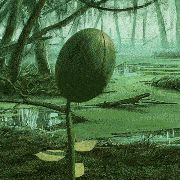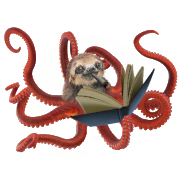|
 NAME: PEARL OYSTER (PRE-ELEVATE) CLASS: S - (ELEVATED) CLIMATE: TROPICAL BIOME: RAINFOREST SIZE: 0.25-1 m (HEIGHT; PEARL), 1.5-2.5 m (HEIGHT, PEDESTAL to UPPER VALVE) TEMPERAMENT: The pearl oyster is the ancestor of the familiar Pearlian people. Pearl oysters have a unique physiology, completely lacking any external limbs and housing all their internal organs inside a hinged shell. They get by without appendages just fine thanks to a fairly powerful telekinetic ability that allows them to manipulate small objects. Very early populations used to manipulate small stones and pebbles and constructed elaborate languages by placing them in precise patterns. These stone patterns could communicate information to other pearl oysters. Indeed this elegant ability to write, teach and learn lead to the pearl oyster becoming the dominant species in its environment. Just like the Pearlians, pearl oysters consider information to be of the highest import - far more important than food (the pearl oyster, for most intents and purposes, gathers light to power the bulk of their internal processes) and lodging (the pearl oyster is its own house). Over time, pearl oysters honed their ability to communicate via telepathic imaging amongst themselves and most impressively, eventually to other species. Suddenly there was a massive influx of yet more knowledge, information and worldviews for the pearl oysters to take in, which sparked a great migration around their home planet, as they sought to learn and teach everything there was to know about their world. Pearlian law states that the voluntary withholding of information in the proximity of a pearl oyster is an act of cruelty; ignorance is never bliss.This law does not apply to any other creature, however. And although pearl oysters will share every bite of knowledge they can amongst themselves, they will seldom share private knowledge or secrets with other species. Remember, the pearl oysters here at The Rosary Pyramid Zoo can understand over 1649 spoken languages and are not shy about asking personal questions: please answer to the best of your abilities. Plant MONSTER. fucked around with this message at 15:22 on Mar 10, 2023 |
|
|
|

|
| # ? Apr 27, 2024 13:25 |
|
|
Plant MONSTER. posted:
thats my spirit animal right there
|
|
|
|
 NAME: ARMADILLO CLASS: B CLIMATE: DRY BIOME: DESERT, MOUNTAIN RANGE, SIZE: 0.3-0.5 m (HEIGHT) TEMPERAMENT: TIMID, FAMILY-FORMING Spends most of its time with its head tucked into its tough shell. The armadillo's neck is deceptively long and very collapsible, with the vertebra almost sliding in one another like nested cups. Armadillos live in small familial units, usually consisting of one mated pair and a few generations of offspring, although armadillo families generally have no problem sharing space with others of their species. Areas with rock formations that provide shade and shelter are the most sought after. Very timid, usually only the strongest of the mated pair ventures out to gather any resource too far from the home territory. Offspring only leave their home nest when two conditions are met: they've reached their fifth year, and, if they're feeling brave enough. Armadillos would make for exceptionally easy prey if it weren't for their tough shells, made up of extremely dense corneal skin. Unfortunately, a frightened armadillo is more likely to freeze in place than it is to seek shelter and thus, plundering an armadillo (or their young!) is as easy as walking by, stomping one's feet and picking up the frozen creature. It is for this reason armadillo hunting is incredibly unpopular and frowned upon. Although plenty tasty, and easy to roast on account of the shell that traps in succulent flavors, one ought to only resort to eating armadillos under most extreme circumstances. The trade of armadillo flesh is illegal. They feed on tender new plant growth, as well as particularly non-threatening cacti. Plant MONSTER. fucked around with this message at 00:55 on Mar 11, 2023 |
|
|
|
|
 I want to study more of nature's fascinating beauty
|
|
|
|
Who asked for a red panda?? NAME: RED PANDA CLASS: F CLIMATE: TROPICAL, SUBTROPICAL, TEMPERATE BIOME: RAINFOREST, FOREST, URBAN SIZE: 1.6-2.4 m (LENGTH) TEMPERAMENT: FEROCIOUS The much-maligned red panda is known to be an incredibly avaricious eater and will readily try to devour anything it can fit into its expansive maw. The red panda is both a scavenger and a predator. Red pandas adapt their strategies based on what they're hunting. They will forcefully cause herd animals to scatter and will then gang up to pick off the weakest. For something like your average camper or field worker, they will wait until their prey is asleep before making any attempt at an attack. They will pluck eggs from nests, crops from the soil, younglings from their creches and the elderly from their hammocks. Red pandas can reproduce incredibly rapidly and are a serious urban pest because of their ability to thrive in dank polluted areas just as easily as they could in more pristine environments. They are happy to inhabit sewers and abandoned buildings. Red pandas sometimes manage to stow away on spacefare and will then spread to other colonies, provided they don't manage to pick off vital crew members first. Has an incredibly foul odor. Scurries away when the light is turned on. All around unpleasant. Please report any sightings of red pandas outside their enclosures to any one of our friendly attendants and they will kindly dispose of the fetid beast. |
|
|
|
 NAME: FLYING FOX CLASS: E CLIMATE: TROPICAL BIOME: RAINFOREST SIZE: 30-50 cm (HEIGHT), 60-100 cm (WINGSPAN) TEMPERAMENT: GREGARIOUS Small frugivorous mammals capable of impressive sustained gliding and flying. Catches the wind with the membranous sails between each digit. They travel above the canopy in groups of around 8 to 20 during the day, where they seek out ripe fruit. During the evening, they congregate in the underbrush with other foraging groups and roost together in tight clusters. This clustering behavior is also used as a defensive strategy against potential threats: by clumping and linking together, flying foxes can form the impression of a far larger and more threatening creature. They can even fight fairly competently as a unit in this state as well. Even a solitary distressed flying fox is not without its own dangers and should thus still be approached with care; those sharp claw tipped digits and tail can easily puncture and tear flesh! Considered a pest of orchards and fruit plantations, efforts taken to extirpate the flying foxes have been met with intense condemnation and consternation from the public, owing largely to the fact flying foxes are very popular culture icons. Their faces, with their large eyes and "smiling" jaws endear most sentients (even non-elevates or those whose kind lack faces!), stylized depictions of them adorn countless merchandise, captioned holopicts of them are shared on every corner of the Uninet, and Flying Fox Man has been an enduring character whose story has been retold and reimagined in countless ways in over 20 different mediums. The first motion picture translated to the Botanisens form was Flying Fox Man Returns. |
|
|
|
please please please post the flying fox megazord
|
|
|
|
 rough sketch rough sketch
|
|
|
|
 thank you
|
|
|
 |
|
|
|
|
 NAME: SLOTH CLASS: C CLIMATE: SUBTROPICAL, TROPICAL BIOME: JUNGLE, FOREST SIZE: 3-5 m (LENGTH) TEMPERAMENT: LAZY Found perpetually basking on the forest floor. The thick, matted fur of the sloth houses a range of symbiotic algae that provide photosynthetic energy and sugars for the sloth. This diet of dappled light is supplemented with anything that falls within range of the sloth's many arms: fruit, fallen vegetable matter, insects, birds, people, etc. Though physically incapable of fighting, sloths are fiercely guarded by large moths that rely on the sloth's unique jardin of algae for sustenance, thus, approaching a sloth is not recommended for any reason. Curiously, sloths reproduce via spores. Rainfall carries these spores away where they mingle with those of other sloths, forming new slothlings where puddles tend to form. All gas breathers should take heed not to breathe in the spores lest a slothling form in their (book)lungs (or analogous organ)! |
|
|
|
|
|
|
|
|
Plant MONSTER. posted:
i've been doxxed! otoh that's a good picture of me 
|
|
|
|
 NAME: SLOTH MOTH CLASS: F CLIMATE: SUBTROPICAL, TROPICAL BIOME: SPECIAL (FOUND ACCOMPANYING SLOTHS) SIZE: 3-4 m (HEIGHT) TEMPERAMENT: HYPER-AGGRESSIVE Although the sloth is not known for its ferocity or danger (besides the fact they will attempt to eat you if you come within arm's reach), there is a reason efforts are made to relocate budding sloths before they settle near civilization and that reason is the dreadful sloth moth. Sloth moths ensure their slower partners remain hale and healthy by keeping large territories free of anything that would pose a threat to a sloth, allowing only smaller creatures to venture near their partner. Sloth moths have also been seen rending meat off the carcasses of their kills, the collected meat chunks are not used by the moth directly, instead, they are dispersed around their hosts. This behavior is not altruistic: the sloth moth feeds solely upon the moss and algae that grow in the sloth's fur. Unfortunately this protective behavior of the sloth moth makes them incredibly dangerous, they will not hesitate to kill anything or anyone that catches their attention. This killing instinct has earned them a frequent spot on Top 100 Deadliest Killers lists, alongside the likes of shih tzus and roses. Besides their sheer killing powers, the waxy scales that coat their bodies and vestigial wings are highly irritating, causing blistering on any exposed skin as well as potential blindness or asphyxiation should they puncture the eyes or enter the airways. Sloth moths do not need to mate in order to lay fertile eggs. They will only lay an egg if in the presence of unattended (mothless) slothlings or "widowed" sloths. The egg is laid directly on the sloth, the fur and its unique "jardin" keep the egg the proper temperature and moisture. The larva go through several instars in the sloth's fur where they also pupate. A sloth removed from its moth will display signs of distress and will often cry in a way startingly resembling that of a human child's. Plant MONSTER. fucked around with this message at 03:55 on Mar 16, 2023 |
|
|
|
Common brown breasted brownbird plz?
Hoooooo boy. |
|
|
|
 NAME: SHREW CLASS: E CLIMATE: DRY, TEMPERATE BIOME: SUBTERRANEAN, CAVE, GRASSLAND SIZE: 0.3-0.4 m (LENGTH) TEMPERAMENT: SKITTISH BUT DANGEROUS Semi-blind to the light but very nimble, shrews are primarily insectivorous mammaloids (but will happily take most prey) with tough chitinous 'plates' on its body that provide additional defensive protection (and prevents desiccation in more arid environments) to the creature. What truly makes the shrew a threat however, are the claws found on its limbs, as well as the pair of horns on their head and the cercical horns at the rear. These claws and horns are directly connected to various venom glands, which can cause complete paralysis in a far larger creature within minutes. The meat of the shrew is also considered poisonous and is thus generally unfit for consumption. Shrews prefer tight, damp places but can easily be found in more deserted areas. Shrews nest in large groups but do all of their hunting alone. Although equipped with a plethora of defensive and offensive mechanisms, shrews that nonetheless easily startled and a shrew is unlikely to attack if it feels it's being noticed, unless cornered. Mother shrews use their cercical horns to carry their pups around much like how the beloved earwigs dotes on our younglings! |
|
|
|
 NAME: EARWIG CLASS: A (non-elevate crew mates) CLIMATE: TEMPERATE, DRY BIOME: CLIFF, MOUNTAIN SIZE: 1.8-2.3 m (HEIGHT, CERCI TO HEAD) 3.8-4.5 m (WINGSPAN) TEMPERAMENT: NURTURING, PACIFISTIC Nurse bugs, skymums, cradlers, marmies... earwigs have earned themselves so many nicknames due to their long history with the then non-elevate humans of the Lyraen systems. Earwigs are intelligent arthropoids with very powerful parental instincts that extends not only to the young of their own kind, but to those of most any species. This drive to protect, feed, nurture and even teach, has been inadvertently exploited by early settlers, who noticed this keen interest and tender behavior towards their children. Gradually learning to trust the arthropoids with all manner of infants and children lead to more free time tending to important duties. Children raised with earwig caregivers end up, as a whole, calmer, less anxious and more empathetic than same-species parent only households. Now, earwigs are ubiquitous on familial ships. The strong cerci on their rear ends look fierce but are used solely to gently manipulate eggs, younglings, bedding materials, food matter, toys and homework. Their saliva is also a potent anti-microbial and anti-septic. Earwigs can also be taught basic first aid and have been indispensable in the medical field as doctor or nurse assistants. Earwigs are herbivorous and fungivorous, preferring a colorful and diverse assortment of flowers, lichens and mushrooms. Earwigs are capable of parthenogenesis. Young earwigs are often raised alongside the children of their shipmates. |
|
|
| aahhh it's gonna pinch me with it's butt | |
|
|
|
 NAME: QUEEN CONCH CLASS: E CLIMATE: TEMPERATE-TROPICAL BIOME: JUNGLE, SWAMP, WETLANDS, FOREST SIZE: 3-6 m (BODY TO TIP OF SHELL) TEMPERAMENT: SLOW BUT PREDACIOUS Large terrestrial mollusks with a preference for moist environments. The queen conch's brain and other key organs are stored in the coiled shell, the soft body is responsible for locomotion, feeding, defense, and mating. This soft body has the impressive ability of infinite regeneration as long as the innards in the shell remain intact. The other and perhaps more infamous ability of the queen conch's is its defense that allows it to exploit any would-be threat's mating instincts (should they be present)! The tentacles with valentine-shaped spots each house a 'dart' that can be shot out with remarkable precision, any target pierced by these darts will find themselves feeling overwhelmingly and inappropriately amorous. Although these effects are short lived, this is usually enough for the queen conch to make its escape. The venom is also prescribed as a last-ditch effort to repair waning marriages but the quantity needed and frequency of dosage is seldom worth it. Queen conchs feed on fallen vegetable matter and other detritus. Despises salt. |
|
|
|
 NAME: CAPYBARA CLASS: S CLIMATE: PRISTINE BIOME: MEADOW SIZE: 160 cm (LENGTH), 80 cm (HEIGHT; FEET TO HORN) TEMPERAMENT: PEACEFUL, BENEVOLENT One of the crown jewels of the entire Rosary Pyramid collection, the capybara is a creature so rare, they were thought to be mere legends. For reasons not fully understood, any creature within proximity of the capybara become calm and placid, any aggression or anxiety that may have been present is immediately and completely dispelled. This peaceful aura allows for all sorts of inter-special mingling, and the communal enclosure of the capybara has been dubbed Eternal Elysium. Behaviors of wild capybaras have not been recorded due to their immense rarity. But the one capybara in our collection, named Franco, has the curious tendency to approach sick animals and gently prod them with his horn. This action appears to speed up healing, yet another enigma that surrounds the capybara. Doesn't appear to age, cellular damage is repaired instantly. Doesn't need to eat but will readily consume candy. |
|
|
|
 NAME: SEA ANEMONE CLASS: D CLIMATE: SUBTROPICAL BIOME: SWAMPLAND, SHALLOW WATER SIZE: 1.6 -3.2 m (HEIGHT) TEMPERAMENT: SLOW, PREDATORY Soft bodied animals that inhabit moist environments,; prone to desiccation. The pitiful face contrasts the beautiful tentacles. These tentacles are incredibly sticky and stretchy and are used to ensnare prey. Not particularly picky and will most likely try to feed on anyone who approaches it. Reproduces by budding. Buds will detach from the main body after attaining a large enough size but until then, they assist with feeding the main body by catching prey themselves. Buds can merge with buds from other anemone, forming a hybrid. Sea anemone come in a beautiful assortment of colors. Sea anemone collecting and breeding is a major hobby among some, with entire gardens devoted to exhibiting prized anemones. |
|
|
|
https://www.youtube.com/watch?v=fXgczro95lk
https://i.imgur.com/9jTkSUL.mp4 |
|
|
|
 NAME: GIRAFFE CLASS: D CLIMATE: SUBTROPICAL, TEMPERATE BIOME: SCRUBLAND, FOREST EDGE, SAVANNAH SIZE: 4.5-5.8 m (HEIGHT; HEAD TO TIP OF TAIL) TEMPERAMENT: SHY Bizarre, long-necked arboreal mammaloids with a strong prehensile tail that allow them to dangle from tree limbs while they graze on tender grasses and herbs below. Very skittish, giraffes will retreat into the canopy of their tree if they sense a predator nearby. This timid behavior does not extend to other giraffes; there can only be one giraffe per tree and the trees with the best vantage and proximity to resources are frequently fought over. They will engage in violent "tail jousts", which often results in both giraffes heavily injured. Watching a giraffe travel on land is an interesting sight. Giraffes use their tails to "spring" themselves forward some distance, as well as to prop themselves up, while the limbs are used for traction. Eyes continue to develop down the neck as the creature ages. |
|
|
    
|
|
|
|
|
 NAME: NILGAI (CATTLE) CLASS: D (LIVESTOCK) CLIMATE: DRY BIOME: SCRUBLAND SIZE: 3.6-5.8 m (LENGTH SHOULDER TO HIND) TEMPERAMENT: DOCILE Beloved for its ability to convert the barest grass patches as well as waste and refuse into calorie-rich meat. The the horns and teeth are far more exaggerated in the modern nilgai compared to their wild holstein counterparts, but truly, this startling appearance belies their timid natures. Horns are longer in the females, all sexes will shed their horns twice a year. An enraged nilgai is still very dangerous and indeed, nilgai are responsible for a number of injuries and some fatalities every year. Especially during mating season, when the males and females aggressively joust one another with their horns. This somehow results in mutual pregnancy: males will give birth to daughters and females will birth sons. The milk of the nilgai is considered unusable in industry and unfit for general consumption: the mouthfeel is somehow watery and gritty, it contains complex sugars that are impossible to digest for most of society and the particular shade of grey is very difficult to render more appetizing. Still, a small clade of monks from the Order of the Brothers of the Diocese of Our Holiest Urn-Mothers devote their lives attempting to make cheese from the nilgai's milk. Hundreds of generations have passed and the closest product to success only made five of the brothers gravely ill. |
|
|
| at some point they should accept that theyre lactose intolerant and stop trying to make the cheese work!!! | |
|
|
|
 NAME: HORNED OWL CLASS: E CLIMATE: TEMPERATE, POLAR BIOME: FOREST, MOUNTAIN RANGE SIZE: 2.2-3.5 m (HEIGHT, HORN TO TOES) TEMPERAMENT: OMNIVOROUS, VORACIOUS Both hunter and scavengers, horned owls are powerful bipedal and bicephalic creatures. Horned owls are not picky eaters and will gladly eat foliage, shoots, fruit, mushrooms, carrion and any creature they can overcome and tear apart. The talons are incredibly powerful and the pair of horns on its head act as massive forceps, used for manipulating larger items as well as to crush tough nuts and bones. The brain is housed in the ribcage. The upper head prefers insects and foliage while the lower head craves meat. Besides this dietary preference, both heads share the same sensory experiences, however, much like how some people with limbs prefer the use of one over the other, individuals seem to have a distinct preference over which of their heads they prefer. Both heads are asleep during the day, which discredits the once popular theory that one had acted as sentry while the other slept. There is no special time of the year where breeding occurs. Eggs are laid and immediately forgotten about by the parent. Hatchlings fend for themselves. It is not recommended to approach a horned owl for any reason, as they can and will maim or kill the average citizen with the slightest of provocations. Plant MONSTER. fucked around with this message at 19:50 on Mar 30, 2023 |
|
|
|
Plant MONSTER. posted:The upper head prefers insects and foliage while the lower head craves meat. I love the little details like this
|
|
|
|
Who should I post next? Brachiopod (clam snake) Seahorse (grassy hunter) Brown Bear (yonic mouth) Bagworm (pear gremlin) Ostrich (reptile birdy) Sponge (he's ready!) Sunflower (botanical sarlacc) Llama (Mer-Llama) Plant MONSTER. fucked around with this message at 16:38 on Mar 31, 2023 |
|
|
|
|
Plant MONSTER. posted:Who should I post next? "botanical sarlacc" sounds interesting so I say sunflower
|
|
|
|
 NAME: SUNFLOWER CLASS: E CLIMATE: DRY BIOME: SANDY DESERT SIZE: HIGHLY VARIABLE. AVG. 10-16 m (WIDTH; CAPITULA), 20-35 m (HEIGHT; BODY, SUBMERGED) TEMPERAMENT: MINDLESS, TERRITORIAL WHEN IN BLOOM Extremely large botanical creatures whose entire bodies remain buried deep in the sands of the deserts. During the feeding stage of their life cycle, sunflowers form massive pits in the sand, often 20 meters or more in diameter with steep sloped edges. Anything that loses its footing falls into the cavernous maw of the sunflower that awaits at the bottom of the pit. Large teeth grind everything up into a pulp and the entire bolus is deposited into the massive buried sac-like body. When a sunflower reaches maturity, usually after 10-14 years, they begin to bloom. During blooming, the jaws shut and the entire capitulum rises several meters into the air on a study, woody stalk. Several rings of large, golden petals unfurl and encircle the edge of the captilum. These petals signify the arrival of copious nectar and pollen secretion, which attracts flying creatures of all manner to enjoy a wonderful sugary feast whilst transferring pollen from other sunflowers. This display is followed by the rapid appearance of many smaller buds that emerge from the main body and rise above the central capitulum. These smaller buds are known as 'asteroids' and are used to attack anything that would deign to take a bite out of the sunflower while in this flowering state. After pollination, seeds are formed on the inside of the sunflower's body cavity and are forcefully ejected from the mouth once they are ripe. Seeds can travel many miles in this manner. Seeds instinctively bore deep into the sand and begin germination. We have marked all known sunflower pits with an eye-catching tawny beige colored flag. |
|
|
|
|
excellent critter... pear goblin intrigues me tho! |
|
|
|
 NAME: SEAHORSE CLASS: D CLIMATE: TEMPERATE, SUBTROPICAL BIOME: GRASSLAND, SAVANNAH, FOREST SIZE: 30-40 cm (HEIGHT) TEMPERAMENT: AMBUSH-PREDATOR Stealthy piscoid hunters that make their homes in vast seas of grass or amongst the branches in the thick underbrush. Seahorses use their tentacles to either firmly plant themselves into the ground if living in open grasslands, or to brachiate from shrub limb to limb if in the woods. The bright green coloration and striking black stripes help break up the seahorse's silhouette, allowing it to blend in very effectively with the surrounding vegetation and also acts as an aposematic warning to anything who wishes to taste a seahorse: these creatures are as poisonous as they are venomous! Seahorses employ a number of chemical defenses for use in hunting as well as protection and have been known to modify their strategies based on the target. Seahorses can spray a potent acid from their nostrils with great accuracy. This acid is capable of causing disfigurement and permanent blindness if it should get into the eyes, which the seahorse tends to aim for, unfortunately. If hunting small, insectoid prey, they will instead spit out a frothy, soapy substance that blocks the prey's breathing spiracles, knocking them out very quickly. They feed with a suctioning action from their telescoping nostrils, which also liquefy their food with small amounts of acid. Areas pocked with seahorses are recognizable from the strong grassy aroma that they tend to emit when in large clusters. We recommend wearing sunglasses when exploring the deeper forested parts of the Zoo! |
|
|
|
|
"a small clade of monks" lmao Fifteen years taking prescriptions |
|
|
|
 NAME: BAGWORM CLASS: D CLIMATE: TEMPERATE, SUBTROPICAL BIOME: FOREST, GARDEN SIZE: 14-22 cm (HEIGHT OF CREATURE INSIDE BOTANICAL STRUCTURE) TEMPERAMENT: CURIOUS BUT SHY Small insectoid animals that spend most of their lives encased in a protective shell of botanical origin. This shell begins as a developing fruit of woody plants in the Maluspyrus family. Once a gravid bagworm has laid its egg, it seeks out an acceptable immature fruit for its young. It pierces a small hole into the fruit and secretes a specialized growth hormone that causes the fruit to rapidly grow in size and undergo physiological changes that make it more durable and hospitable for the egg. This brief venture is one of the few times the bagworm leaves its home - after the fruit is chosen and the egg is deposited, the bagworm quickly scurries back to the safety of its shell. Hated by farmers for its tendency to select prized fruit and beloved by hobbyists who actively coerce bagworms to make homes out of meticulously grown fruit. These hobbyists often hybridize their own plants to produce fruit with outrageous shapes and colors. Some try to go a step further and attempt to encrust precious gems and metals to the fruit but more often than not, the bagworm will pick off and violently discard these adornments. Bagworms feed on the nectar from flowers, sap from young tree branches, the juice from mature fruit and and the spilled viscera from dead animals. The latter source of food is often omitted from pop culture depictions of bagworms, who are more often than not portrayed as sympathetic and darling little tree dwellers. |
|
|
|
 NAME: SPONGE CLASS: B CLIMATE: ARCTIC TO TROPICAL BIOME: BEACHES SIZE: 30-50 cm (HEIGHT; DRIED) 1.5-2.2 m (HEIGHT; HYDRATED) TEMPERAMENT: ANXIOUS (DRIED), PLACID (HYDRATED) Composed of a highly porous and absorbent body adhered to a dense hydraulic vascular system, the sponge can efficiently channel water in and out of its body and vascular system to perform impressively mobile maneuvers. However, because of its unique composition, a sponge requires access to water in order to feed. Waters fertile with organic compounds and rich with microbiota provide all the necessary food for the sponge, the purified water that remains then serves as the hydraulic fluid necessary for movement. Sponges can expel this clean water from any of the larger orifices and have been integral to the survival of many populations living near unclean water. A sponge that has not replenished its water reserve will begin to behave more and more hurried and erratic, displaying rude behaviors such as running and shoving as it desperately seeks out water. However, sponges that absorb too much water become languid and lazy, which can be rectified with a technique known as "wring-hugging"; a caress that serves to gently remove excess water from the spongy tissues. Keeping water levels at a stable level is integral to healthy emotional regulation in sponges. Sponges seem to imprint onto humanoid persons, perhaps due a shared (but superficial) overall body shape and seem to enjoy following others around, mimicking their actions from time to time. This congenial attitude towards a great number of Farers and Elevates alike and ability to filter and purify bodies of water makes the sponge an indispensable aid in the early stages of planetary exploration. |
|
|
|
 NAME: BROWN BEAR CLASS: F CLIMATE: TEMPERATE, ARCTIC BIOME: FOREST, TUNDRA, URBAN SIZE: 2.2-2.5 m (HEIGHT) TEMPERAMENT: VORACIOUS, TERRITORIAL Long considered a pest that greedily devours entire crops, plunders livestock indiscriminately and won't hesitate to kill just to stake claim over what it considers choice pickings (more often than not, this is something too putrid for most pallets). Most of the brown bear's internal cavity is devoted to housing its massive stomach, which allows it to eat quantities far beyond other creatures their size. Brown bears also possess a powerful immune system and are seldom poisoned by what they ingest, no matter how rotten or rancid their feast might be. The jaws are very weakly developed, instead, powerful muscles function as a sphincter, sort of acting like the drawstrings of a pouch. Numerous curved teeth line the oral entrance, which rasp at the flesh and greatly hinder any attempt at escape. Fortunately, brown bears do prefer to kill their prey before consuming. Unfortunately killing is often accomplished via a constrictive tongue and powerful arms. Satiated brown bears undergo immediate hibernation, which can last between 16 hours to several months but usually falls within a range of a few weeks. Still, it is never advised to approach even a hibernating brown bear, as some have been known to fake dormancy in order to lure in unsuspecting prey who think they've chanced upon an easy, lazing target. All brown bears at the Rosary Pyramid Zoo are kept completely satiated at all times, however, so don't be shy and say hello! IF YOU SEE A BEAR IN AN ACTIVE STATE, DO NOT SAY HELLO. |
|
|
|

|
| # ? Apr 27, 2024 13:25 |
|
Hello!
|
|
|




























